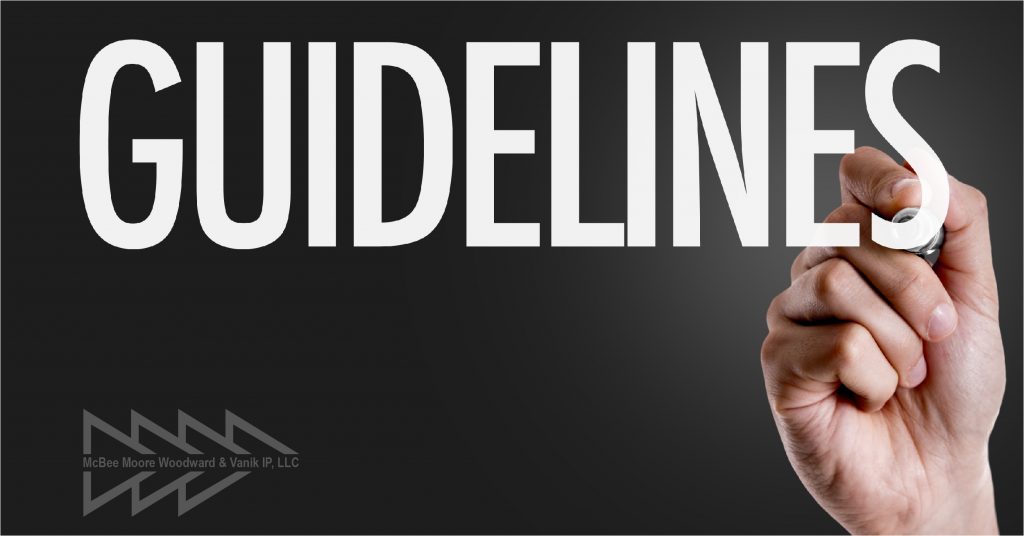USPTO Releases 2019 Revised Patent Subject Matter Eligibility
- January 10, 2019
- Posted by: Susan McBee
- Category: Blog

Background
The USPTO’s 2019 Revised Patent Subject Matter Eligibility Guidance clarifies the Office’s view of what constitutes an “abstract idea,” and proposes a revised procedure for how the Office will determine whether claimed subject matter is directed to a judicial exception (Step 2A, of the Mayo/Alice test for eligibility). The goal is to increase predictability and consistency in the analysis. While the guidance will likely be useful for business methods and inventions in the computer arts, it does not appear to provide much clarity on the Office’s approach to determining whether a claim covers a natural product. Below is a summary of the Guidance.
Summary
First, the Guidance explains that abstract ideas include the following groups of subject matter:
- Mathematical concepts such as mathematical relationships, formulas, or calculations
- Certain methods of organizing human activity, such as fundamental economic principles (hedging or mitigating risk); commercial or legal interactions; advertising, marketing or sales activities; personal behaviors (social activities, teaching, following rules);
- Mental processes performed in the human mind including observations, judgments and evaluations.
Claims that do not recite subject matter in the above groupings will not be treated as an abstract idea–there is no judicial exception and the analysis ends. Claims that cover subject matter not specifically enumerated above will be treated as reciting an abstract idea and further analysis of Step 2A is warranted.
Second, for procedural analysis of Step 2A (including abstract ideas, laws of nature and natural phenomenon), the Guidance instructs examiners to first look at the claim as a whole to determine whether it covers a judicial exception (not eligible) or if the claim covers a practical application of a judicial exception (eligible). In determining whether the claim recites a practical application, the Office will consider whether the claim imposes a meaningful limit on the judicial exception. Here, the Guidance suggests that the Office will analyze whether the claimed subject matter monopolizes a judicial exception and will attempt to discern between clever drafting and meaningful limitations. If the Office determines that the claim as a whole is a practical application of a judicial exception, the analysis concludes, and the claim is eligible. Notably, there is to be no consideration at Step 2A of whether the claim recites well-understood, routine or conventional activity in order to determine whether the claims is a practical application of a judicial exception.
Third, if the Office determines that the claim is not a practical application of a judicial exception, there is still hope for Applicants under Step 2B, which asks whether the claim recites elements that transforms the judicial exception into something significantly more than the judicial exception. Here, elements that are not routine or well-understood will still confer eligibility in some cases. While the revised procedures for analyzing Step 2A apply to natural products and laws of nature in addition to abstract ideas, it is unclear how the procedures will aid a determination of whether claimed subject matter covering a product derived in part from a natural product represents “practical application” of a natural product. The Guidance indicates that it “supersedes MPEP 2106.04(II)…to the extent that it equates claims ‘reciting’ a judicial exception with claims ‘directed to’ a judicial exception.” Currently, MPEP § 2106.04(b) and (c) apply to determining eligibility for laws of nature and products of nature, and instructs (Step 2A) examiners to compare product claims to the “closest” naturally-occurring counterpart and evaluate the claimed product for “markedly different” characteristics from that “closest” naturally-occurring counterpart.
Our Takeaways
Our takeaways from the Revised Guidance for Applicants in the biotech and pharmaceutical arts is that applicants should continue to recite practical application in the claims, for example, add “treatment” or “prevention” language when drafting method claims for treatment and/or diagnosis of diseases, and/or to recite specific outcomes achieved by the method, where possible. Where this is not possible, then Applicants should continue to rely on claiming non-conventional steps or methods used in the process. Applicants in the computer arts should draft claims ensuring that any use of a computer is more than as merely a tool to implement an e.g., mathematical formula. Applicants with claims covering one of the enumerated abstract ideas should continue to avoid relying on insignificant post-solution activity (analyzing, collecting data) and focus instead on use of that idea to transform an article into something different.
